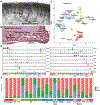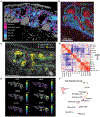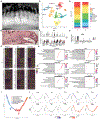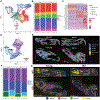The effects of age and dysfunction on meibomian gland population dynamics
- PMID: 39122180
- PMCID: PMC11884644
- DOI: 10.1016/j.jtos.2024.08.005
The effects of age and dysfunction on meibomian gland population dynamics
Abstract
Purpose: While meibomian gland dysfunction (MGD) is widely recognized as a major cause of evaporative dry eye disease, little is known about normal gland differentiation and lipid synthesis or the mechanism underlying gland atrophy and abnormal lipid secretion. The purpose of this study was to use single-cell and spatial transcriptomics to probe changes in cell composition, differentiation, and gene expression associated with two murine models of MGD: age-related gland atrophy in wild-type mice and altered meibum quality in acyl-CoA wax alcohol acyltransferase 2 (Awat2) knockout (KO) mice.
Methods: Young (6 month) and old (22 month) wild type, C57Bl/6 mice and young (3 month) and old (13 month) Awat2 KO mice were used in these studies. For single-cell analysis, the tarsal plate was dissected from the upper and lower eyelids, and single cells isolated and submitted to the UCI Genomic Core, while for the spatial analysis frozen tissue sections were shipped to Resolve Biosciences on dry ice and sections probed in duplicate using a meibomian gland specific, 100 gene Molecular Chartography panel.
Results: Analysis of gene expression patterns identified the stratified expression of lipogenic genes during meibocyte differentiation, which may control the progressive synthesis of meibum lipids; an age-related decrease in meibocytes; and increased immune cell infiltration. Additionally, we detected unique immune cell populations in the Awat2 KO mouse suggesting activation of psoriasis-like, inflammatory pathways perhaps caused by ductal dilation and hyperplasia.
Conclusion: Together these findings support novel mechanism controlling gland function and dysfunction.
Keywords: Age-related meibomian gland dysfunction; Awat2 knockout mouse; Meibomian gland; Single cell RNA sequencing; Spatial transcriptomics.
Copyright © 2024. Published by Elsevier Inc.
Conflict of interest statement
Declaration of competing interest None.
Figures









References
-
- Mishima S, Maurice DM. The oily layer of the tear film and evaporation from the corneal surface. Exp Eye Res 1961;1:39–45. - PubMed
-
- Hom MM, Martinson JR, Knapp LL, Paugh JR. Prevalence of Meibomian gland dysfunction. Optom Vis Sci 1990;67:710–2. - PubMed
-
- Lemp MA, Nichols KK. Blepharitis in the United States 2009: a survey-based perspective on prevalence and treatment. Ocul Surf 2009;7:S1–14. - PubMed
MeSH terms
Substances
Grants and funding
LinkOut - more resources
Full Text Sources
Molecular Biology Databases
Research Materials

